Excerpts from Jim Conrad's
Naturalist Newsletter
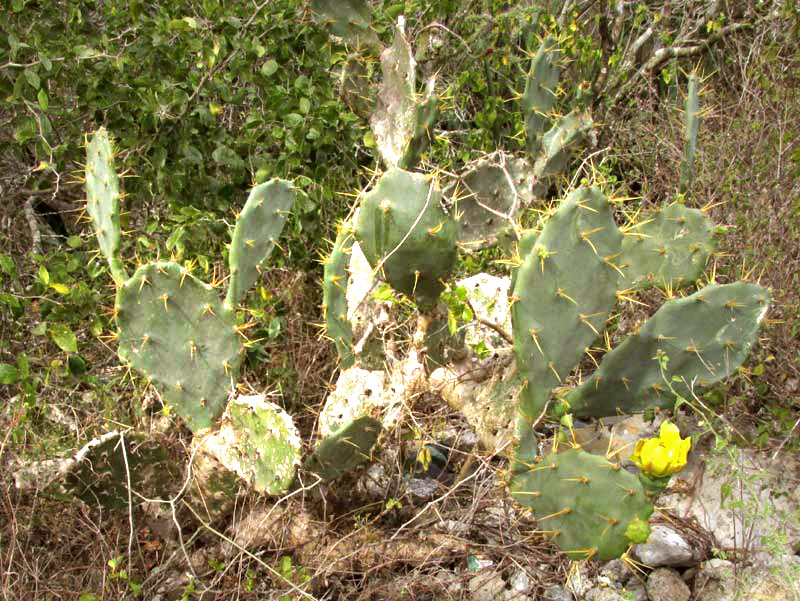
from the January 11, 2015 Newsletter issued from Río Lagartos, on the Yucatan Peninsula's northern coast (~N21.60°, ~W88.16°), Yucatán state, MÉXICO
COASTAL PRICKLY PEAR
It's often been mentioned that cacti here on the Yucatan's northern coast are unusually interesting not only because of their many kinds but also because many of the species are rare and/or narrowly endemic. Not all of our species fit that mold, however, such as the one shown above.
That's the most abundant cactus species in our area, turning up not only in very thin soil atop limestone where few woody species can live, but also in the savanna and fenced-in ranchlands. Sometimes they form extensive, knee-high thickets it's hard to walk through without bloodying your legs. A small patch in a fenced-in ranch area is shown below:
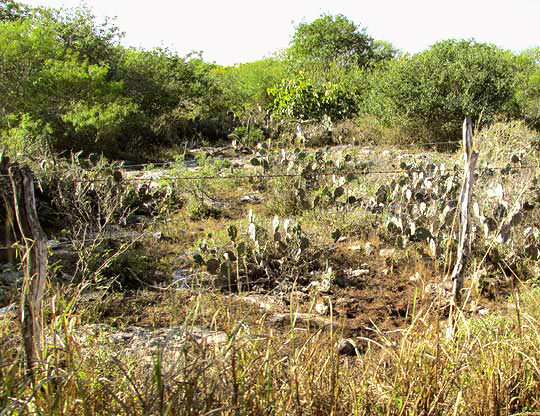
With such flat, beaver-tail-shaped pads, this is obviously a prickly pear cactus, genus Opuntia. However, Opuntia is a big genus, so the challenge is to know which prickly pear this is. I've waited until now to focus on the species because I needed a flower for certain identification. A portrait of its pretty blossom is shown below:
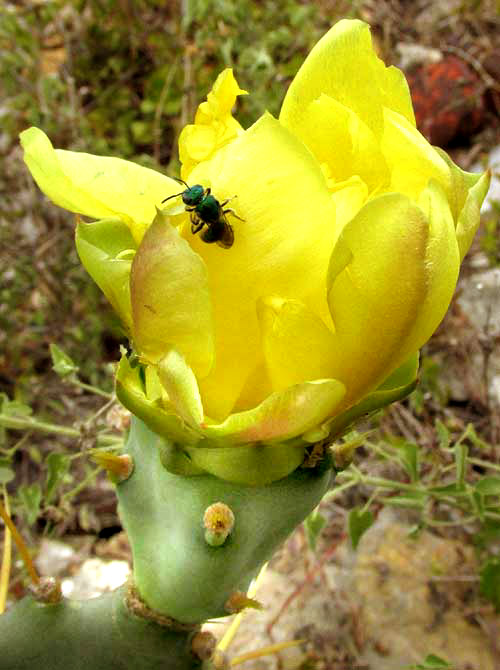
A peep inside the blossom shows that everything is yellow, not with the center tinged with red as with some prickly pear species we've seen. Otherwise there's nothing surprising there, as you can confirm below:
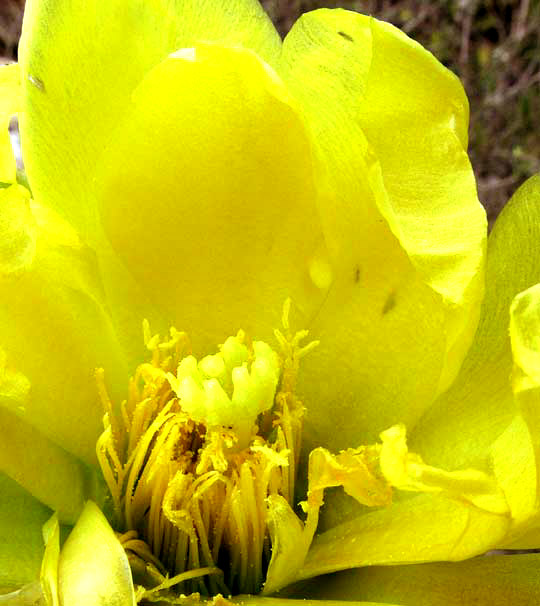 .
.
The cactus's spine clusters are a little more interesting, with yellow spines aging brown, some of them curving, plus there are bristle-spines, or "glochids," at spine cluster's bases forming upward-bristling crescents on one side of the clusters, as shown below:
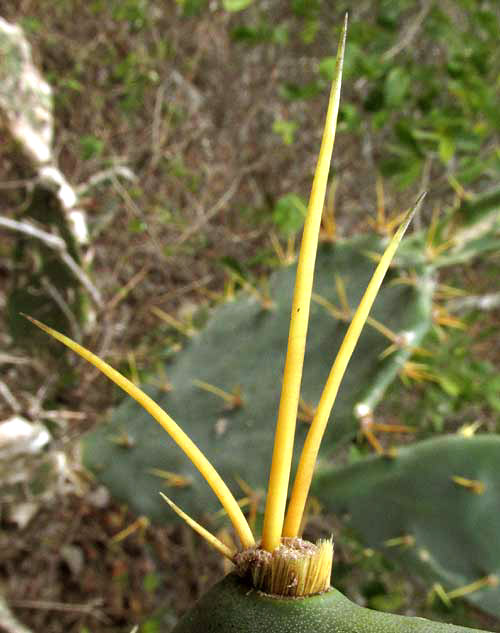
Also a little curious about this species is that it doesn't scramble across the ground like most prickly pear species we've looked at, nor does it arise from a distinctly tree-trunk-like base, but rather it assumes an in-between posture. You can see its base below:
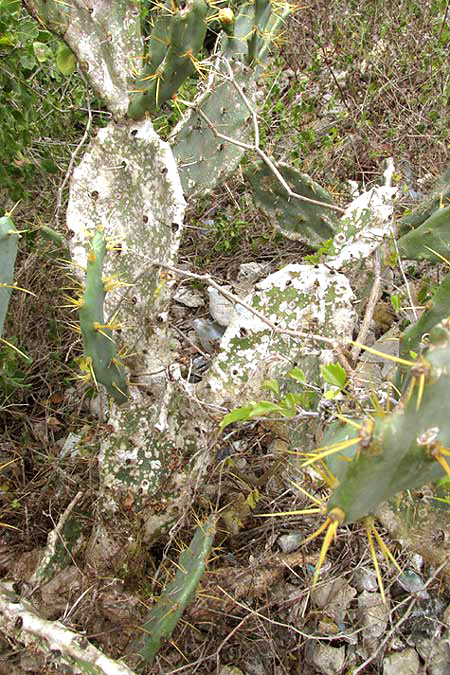
Another good field mark for the species appears in the picture at the top of this page. There, notice the pad margins between spine clusters. The margins are slightly sunken in, giving the pad margins a certain "scalloped" look. Most prickly pear pads don't have scalloped margins.
This is OPUNTIA STRICTA, native in various coastal habitats from the US southeastern states and the Caribbean south to Ecuador. However, this is a vigorous and aggressive species, and now has escaped to become an unwelcome spiny invasive in many tropical and subtropical lands across the Earth. As such it's known by several English names, including Erect Prickly Pear, Common Pest-pear and Pest Pricklypear, but the one seeming most appropriate is Coastal Prickly Pear. Here in its homeland it's seldom seen far from the sea.
It seems that most Internet pages dealing with this species are concerned with its status as an invasive. In Australia at one time it infested millions of acres and still is regarded as a "Weed of National Significance." However, now it's largely been brought under control by the release of large numbers of Cactoblastis moths and the cochineal insect, Dactylopius opuntiae, whose larvae feed on the cactus. In Sri Lanka, it's overgrown a 30 kilometer long coastal area in a national park with special ecological importance as a wetland.
Traditionally, Coastal Prickly Pear has been used in various ways medicinally. In Mexico its mashed pads combined with crushed leaves of the Castor Plant have served as treatments for enlarged spleens.
Because in Mexico its natural enemies keep its numbers in check, Coastal Prickly Pear is a good citizen, a retiring species who knows its place and adds charm and diversity to the landscape. Too bad it's such a nuisance when it goes abroad.
from the March 29, 2015 Newsletter issued from Río Lagartos, on the Yucatan Peninsula's northern coast (~N21.60°, ~W88.16°), Yucatán state, MÉXICO
RED-FLOWERED COASTAL PRICKLY-PEAR
On a birding tour in the savanna/ranchland zone we were passing by a big patch of sprawling prickly-pear cactus that I've always assumed to be yellow-flowering Coastal Prickly-pears, Opuntia stricta. However, the blossoms on the cacti found this week were vividly red, as shown below:
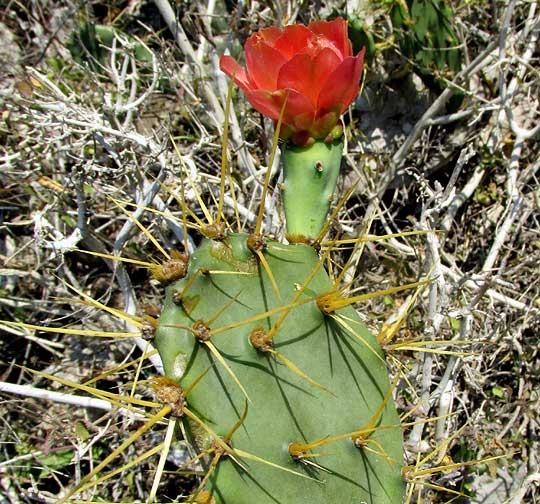
Still, a peep into the blossom's throat showed that the five stigma lobes were pale yellow, just like the Coastal Prickly-pear's, as shown below:
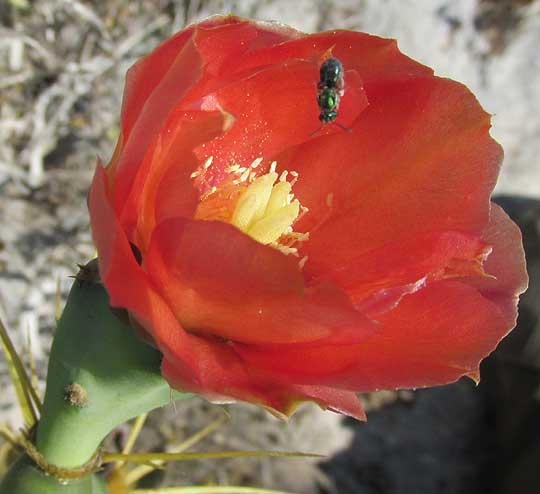
Moreover, each spine cluster of this week's cactus was fringed on one side with many tiny, slender "glochids," and produced several much longer, yellowish, slightly curved spines turning brown as they age, exactly as with the Coastal Prickly-pear, as shown below:
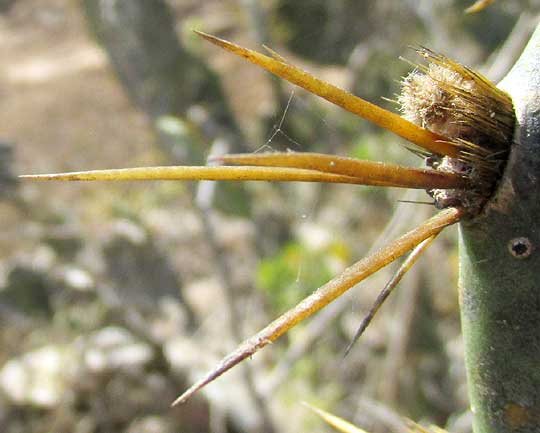
The plants sprawled across the ground without forming a tree-like trunk, as seen below:
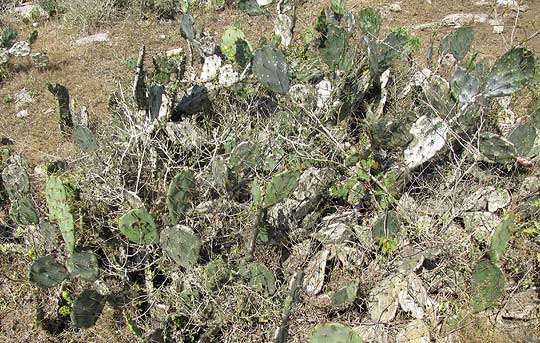
In other words, this seemed like a normal Coastal Prickly-pear, except that it was producing red flowers instead of yellow. On the Internet, the Flora of North America, Wikipedia, the UN's FAO, and the Florida Native Plant Society all say that the Coastal Prickly-pear's flowers are yellow. However, CICY, the Yucatan's central institution for science, shows both yellow and red flowers for the species.
Therefore, since CICY's experts seem to be pretty good, and our red-flowered plants seem to be Coastal Prickly-pears in every respect except flower color, I'm going along with CICY: Coastal Prickly-pear can have either yellow or red flowers, at least here along the Yucatan's northern coast.